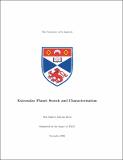Files in this item
Extrasolar planet search and characterisation
Item metadata
| dc.contributor.advisor | Wood, Kenny | |
| dc.contributor.advisor | Cameron, A. C. | |
| dc.contributor.advisor | Seager, Sara | |
| dc.contributor.author | Hood, Ben Andrew Ashcom | |
| dc.coverage.spatial | 147 | en |
| dc.date.accessioned | 2007-07-05T08:34:39Z | |
| dc.date.available | 2007-07-05T08:34:39Z | |
| dc.date.issued | 2007-06-19 | |
| dc.identifier.uri | https://hdl.handle.net/10023/359 | |
| dc.description.abstract | Over two hundred extrasolar planets have been discovered to date with various methods. This thesis reports on searching for extrasolar planets and characterising them by simulating their atmospheres. We used open clusters as targets for deep transit searches, with specific emphasis on the University of St. Andrews Planet Search at the Isaac Newton Telescope. We reduced CCD photometry and described the algorithm we used to search for transits. We estimated the number of transits we expect from our data. We then reduced photometry for the open cluster NGC 6940. From that data we found 18 low-amplitude, short-duration events, though none are transiting planets. They are all eclipsing binary stars. However, our null result constrains the number of planets around M dwarfs, the most numerous stars in our sample. In order to characterise reflected light from extrasolar planets, we built a three-dimensional Monte Carlo based radiation transfer model of extrasolar planetary atmospheres. We detailed the input parameters of the model, and show results of various models, focusing especially on the fractal nature of the clouds of our models, because these are the first three dimensional radiation transfer models of extrasolar planet atmospheres. We found very low geometric albedos in our simulations. Using data specific to the transiting planet HD 209458b, we built a model atmosphere with Rayleigh-scattering hydrogen gas and clouds of enstatite and iron. We show in several models the rarity of a bright HD 209458b, and conclude with some explanations on why extrasolar planets are likely dark and not detected with reflected light. | en |
| dc.format.extent | 28636258 bytes | |
| dc.format.mimetype | application/pdf | |
| dc.language.iso | en | en |
| dc.publisher | University of St Andrews | |
| dc.subject | Astronomy | en |
| dc.subject | Planets | en |
| dc.subject.lcc | QB820.H7 | |
| dc.subject.lcsh | Extrasolar planets--Remote sensing | en |
| dc.subject.lcsh | Extrasolar planets--Atmospheres--Mathematical models | en |
| dc.subject.lcsh | Stars--Open clusters | en |
| dc.subject.lcsh | Transits | en |
| dc.title | Extrasolar planet search and characterisation | en |
| dc.type | Thesis | en |
| dc.type.qualificationlevel | Doctoral | en |
| dc.type.qualificationname | PhD Doctor of Philosophy | en |
| dc.publisher.institution | The University of St Andrews | en |
This item appears in the following Collection(s)
Items in the St Andrews Research Repository are protected by copyright, with all rights reserved, unless otherwise indicated.

